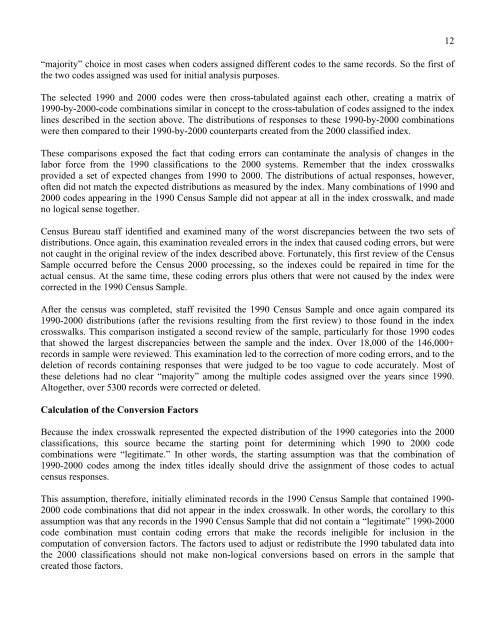The Relationship Between The 1990 Census and ... - Census Bureau
The Relationship Between The 1990 Census and ... - Census Bureau
The Relationship Between The 1990 Census and ... - Census Bureau
Create successful ePaper yourself
Turn your PDF publications into a flip-book with our unique Google optimized e-Paper software.
“majority” choice in most cases when coders assigned different codes to the same records. So the first of<br />
the two codes assigned was used for initial analysis purposes.<br />
<strong>The</strong> selected <strong>1990</strong> <strong>and</strong> 2000 codes were then cross-tabulated against each other, creating a matrix of<br />
<strong>1990</strong>-by-2000-code combinations similar in concept to the cross-tabulation of codes assigned to the index<br />
lines described in the section above. <strong>The</strong> distributions of responses to these <strong>1990</strong>-by-2000 combinations<br />
were then compared to their <strong>1990</strong>-by-2000 counterparts created from the 2000 classified index.<br />
<strong>The</strong>se comparisons exposed the fact that coding errors can contaminate the analysis of changes in the<br />
labor force from the <strong>1990</strong> classifications to the 2000 systems. Remember that the index crosswalks<br />
provided a set of expected changes from <strong>1990</strong> to 2000. <strong>The</strong> distributions of actual responses, however,<br />
often did not match the expected distributions as measured by the index. Many combinations of <strong>1990</strong> <strong>and</strong><br />
2000 codes appearing in the <strong>1990</strong> <strong>Census</strong> Sample did not appear at all in the index crosswalk, <strong>and</strong> made<br />
no logical sense together.<br />
<strong>Census</strong> <strong>Bureau</strong> staff identified <strong>and</strong> examined many of the worst discrepancies between the two sets of<br />
distributions. Once again, this examination revealed errors in the index that caused coding errors, but were<br />
not caught in the original review of the index described above. Fortunately, this first review of the <strong>Census</strong><br />
Sample occurred before the <strong>Census</strong> 2000 processing, so the indexes could be repaired in time for the<br />
actual census. At the same time, these coding errors plus others that were not caused by the index were<br />
corrected in the <strong>1990</strong> <strong>Census</strong> Sample.<br />
After the census was completed, staff revisited the <strong>1990</strong> <strong>Census</strong> Sample <strong>and</strong> once again compared its<br />
<strong>1990</strong>-2000 distributions (after the revisions resulting from the first review) to those found in the index<br />
crosswalks. This comparison instigated a second review of the sample, particularly for those <strong>1990</strong> codes<br />
that showed the largest discrepancies between the sample <strong>and</strong> the index. Over 18,000 of the 146,000+<br />
records in sample were reviewed. This examination led to the correction of more coding errors, <strong>and</strong> to the<br />
deletion of records containing responses that were judged to be too vague to code accurately. Most of<br />
these deletions had no clear “majority” among the multiple codes assigned over the years since <strong>1990</strong>.<br />
Altogether, over 5300 records were corrected or deleted.<br />
Calculation of the Conversion Factors<br />
Because the index crosswalk represented the expected distribution of the <strong>1990</strong> categories into the 2000<br />
classifications, this source became the starting point for determining which <strong>1990</strong> to 2000 code<br />
combinations were “legitimate.” In other words, the starting assumption was that the combination of<br />
<strong>1990</strong>-2000 codes among the index titles ideally should drive the assignment of those codes to actual<br />
census responses.<br />
This assumption, therefore, initially eliminated records in the <strong>1990</strong> <strong>Census</strong> Sample that contained <strong>1990</strong>-<br />
2000 code combinations that did not appear in the index crosswalk. In other words, the corollary to this<br />
assumption was that any records in the <strong>1990</strong> <strong>Census</strong> Sample that did not contain a “legitimate” <strong>1990</strong>-2000<br />
code combination must contain coding errors that make the records ineligible for inclusion in the<br />
computation of conversion factors. <strong>The</strong> factors used to adjust or redistribute the <strong>1990</strong> tabulated data into<br />
the 2000 classifications should not make non-logical conversions based on errors in the sample that<br />
created those factors.<br />
12
















